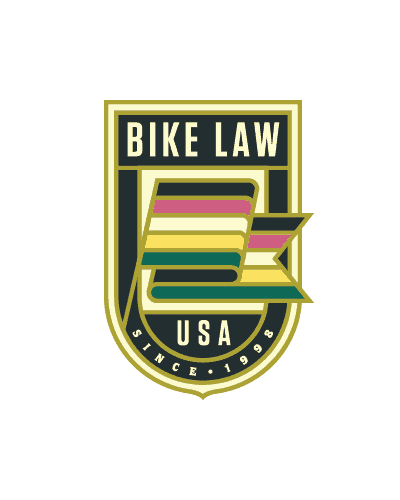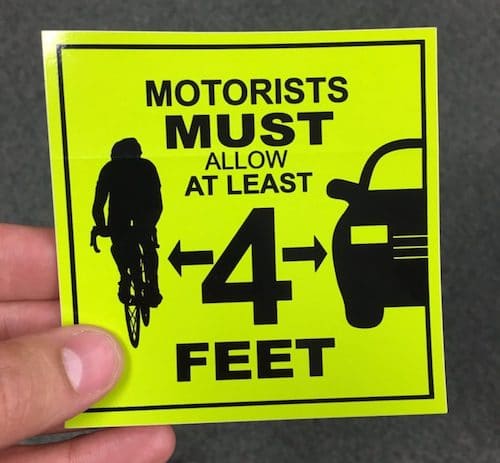
It’s important to know your legal rights (and duties) when bicycling in Pennsylvania. It is especially important after a bicycle accident (we call them bicycle “crashes” and explain why here).
This is a general overview of Pennsylvania’s bicycle laws. To see them in their completion, please visit Pennsylvania’s Department of Transportation. Feel free to reach out to Bike Law’s National Director Rachael Maney for further information.
The information below comes from the Pennsylvania Consolidated Statutes, Title 75, Vehicles, which is also known as “The Vehicle Code.” There are several relevant chapters within the Code noted below, including Chapter 31 “General Provisions;” Chapter 33 “Rules of the Road;” Chapter 35 “Special Vehicles & Pedestrians;” Chapter 37 “Miscellaneous Provisions;” and Chapter 39 Driving after Drinking/Using. Below, we highlight several key laws in the state of Pennsylvania.
Please note that this list is not comprehensive.
Pennsylvania requires that a bicyclist, traveling at a speed less than the speed of traffic, “shall be driven in the right-hand lane then available for traffic, or as close as practicable to the right-hand curb or edge of the roadway”, except:
Noteworthy:
AFRAP

Pennsylvania requires that the driver of a motor vehicle overtaking a bicycle traveling in the same direction “…shall pass to the left of the pedalcycle within not less than four feet at a careful and prudent reduced speed.”
Source: 75 Pa. Cons. Stat. §3303 (2016)
Noteworthy:
Pennsylvania is the ONLY state which has a four-feet passing law on the books under all circumstances. North Carolina and South Dakota include four and six feet passing laws when certain conditions are met. Pennsylvania is also one of a handful of states that specifically require the passing vehicle to REDUCE SPEED. More than half of our states have laws citing specific three-feet passing zones. Unfortunately, 19 states have Safe Passing Laws which remain unclear and poorly defined. More detail below:
Pennsylvania specifically requires vehicles turning right to not cross the path of a moving
cyclist riding along the right edge of a roadway.
Source: 75 Pa. Cons. Stat. §3331 (2016)
Noteworthy:
Drivers almost never look in their right mirror when turning right. This section specifically protects a cyclist from a right turning vehicle.
Pennsylvania currently has the following law aimed at distracted driving, subject to limited exceptions:
Noteworthy:
Create a Viable “Textalizer”
Change the Penalties
In Pennsylvania traffic laws for vehicles apply to bicycles;
“Every person riding a bicycle upon a roadway shall be granted all of the rights and shall be subject to all of the duties applicable to the driver of a vehicle by this title, except as to special provisions…” This includes the requirement to signal turns by hand, including stopping. (3335-3336).
Source: 75 Pa. Cons. Stat. §§3501 (2016)
This section states that bikes may be ridden on a shoulder of a highway, traveling in the same direction as traffic. It also allows for not more than two riders abreast except on bike paths or roads set aside for bikes.
The requirement for a cyclist to use available bicycle lanes/paths was removed from the statutes in 1998. However, we do encourage the use of designated bike lanes/paths for safety.
According to The Code in Pennsylvania, when cyclists are riding between sunset and sunrise, the bike must have a front lamp emitting white light “…visible from a distance of at least 500 feet to the front…” and must have a red reflector light in the rear of the bike which is “…visible at least 500 feet to the rear…” Lastly, the code requires that amber reflectors are placed on both sides of the bike.
Source: 75 Pa. Cons. Stat. §§3507 (2016)
Pennsylvania allows bicycles to operate on sidewalks subject to the following rules:
Source: 75 Pa. Cons. Stat. §3508 (2016)
Pennsylvania requires that any person under the age of 12 riding a bicycle, as an operator or passenger, must wear a protective bicycle helmet.
However, in no event shall the failure to wear a required helmet be used as evidence in a trial of any civil action; nor shall any jury in a civil action be instructed regarding violations of the law requiring helmets; nor shall failure to use a helmet be considered as contributory negligence.
Source: 75 Pa. Cons. Stat. §3510 (2016)
Noteworthy:
California, Delaware and New Mexico are the most progressive states in this area as their laws require helmets for cyclist’s younger than 18. New Jersey is a close second, requiring helmets for cyclists under 17. Twelve other states put the required helmet age at under 16, while seven states place the age between 12 and 15. 28 states are completely silent on the issue of helmets.
To see where your state stacks up against others in safe passing laws, look here.
We strongly encourage the use of a helmet because of its ability to prevent or minimize serious head injuries if you are involved in a bicycle crash.
Pennsylvania restricts the use of e-bikes to those over 16.
Source: 75 Pa. Cons. Stat. §3514 (2016)
Section 3314 of the vehicle code specifically prohibits the use of headphones by vehicle operators. This has been held by caselaw to apply to a motorcyclist wearing earbuds under his helmet. The above-quoted section making all laws applicable to drivers of vehicles applicable to cyclists means that the common practice of riding with earbuds is technically illegal in the Commonwealth of Pennsylvania.
Pennsylvania requires that “No person open any door on a motor vehicle unless and until it is reasonably safe to do so and can be done without interfering with the movement of other traffic…” In addition, no person shall leave a door open on a side of a vehicle available to moving traffic for a period- of- time longer than necessary to load or unload passengers.
Source: 75 Pa. Cons. Stat. §3705 (2016)
Noteworthy:
Promote the “Dutch Reach”
In addition to a state’s Dooring Law, we should consider adopting a driving practice which can become a mandatory part of our driving education system. That’s what the Dutch did in creating the “Dutch Reach.” The practice forces the driver (or passenger) to pivot their body towards the street—which automatically points their vision to where an oncoming bicycle may be coming. This practice would address and reduce the root cause of most door injuries: the motorist’s failure to check behind them before exiting their vehicle towards the street.
As we all know as motor vehicle drivers, Pennsylvania’s Vehicle Code prohibits driving vehicles while intoxicated or after using controlled substances. The Code also states that bicycles are defined as vehicles and therefore this same law is applied to bicyclists. Bicycles should not be operated while the rider is under the influence of alcohol or other controlled substances.
Source: 75 Pa. Cons. Stat. §§3802 (2016)
The Vehicle Code for PA: Title 75
Also from Penn DOT is a publication called “Pennsylvania Bicycle Driver’s Manual” as well as “Street Smarts: Bicycling’s Traffic Survival Guide.” The copyright on this publication is 1988.